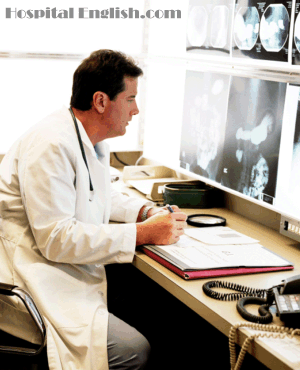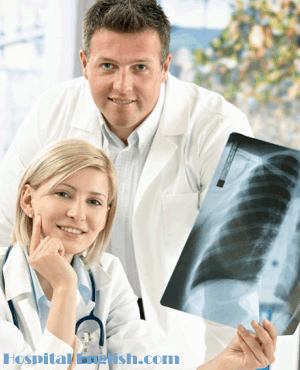Healthcare Professional Articles: Vocabulary, listening, and reading exercises for students to learn and practice English.
Radiology
Vocabulary:
CT scans
department
diagnose
diagnostic
disease
fields
imaging
interventional
MRI scans
physicians
radiation
radiologists
radiology
soft tissue
specialty
therapy
treat
ultrasound
x-rays

Listen to the Radiology article:
Listen and try to answer the discussion questions or take the quiz. You can also listen and read along with the script below.
Listen to the audio file for Radiology and then you can try the discussion questions again. Listen as many times as you need to answer the questions. (You can read the full articles below.)
Follow-up: After completing the discussion exercises, try the tell a partner everything you can about the radiology department and radiologists.
For self study: Verify you understand the key words for the articles. Then try to answer the following conversation questions, speaking out loud.
Discussion Questions:
- What equipment can you find in radiology?
- What tests are performed in the radiology department?
- What role does the radiology department play in patient care?
- What are the differences between a CT scan and an MRI?
Reading: read the article and then answer the questions.
Radiology is a medical specialty that uses images to diagnose disease. In the hospital the radiology department is often one of the first places physicians turn to for diagnosis. Physicians that specialize in radiology are called radiologists. Radiology is divided up into several fields.
- Diagnostic radiology uses imaging to diagnose disease.
- Interventional radiology uses imaging to guide procedures.
- Radiation therapy uses radiation to treat diseases.
The radiology department provides many services in the hospital. Some include the following:
- X-rays, which are used to evaluate bony structures and soft tissue.
- CT scans, which use x-rays and computers to make 3-D images of soft tissues.
- Ultrasounds, which are used to see soft tissue structures in real time, without dangerous radiation.
- MRI scans, which give the best images of soft tissue structures, but patients must stay still for very long periods.

End User License Agreement: You are free to download any resource from this site as an end user and MES-English.com grants you an End User License with the following restrictions: You may not redistribute, copy, modify, transfer, transmit, repackage, charge for or sell any of the materials from this site. You may use photocopies or printouts for distribution to your students. MES reserves the right to terminate or make changes to this agreement for any reason and without notice.
Copyright © 2006 - 2025 Hospital English | restrictions | privacy | about | contact

